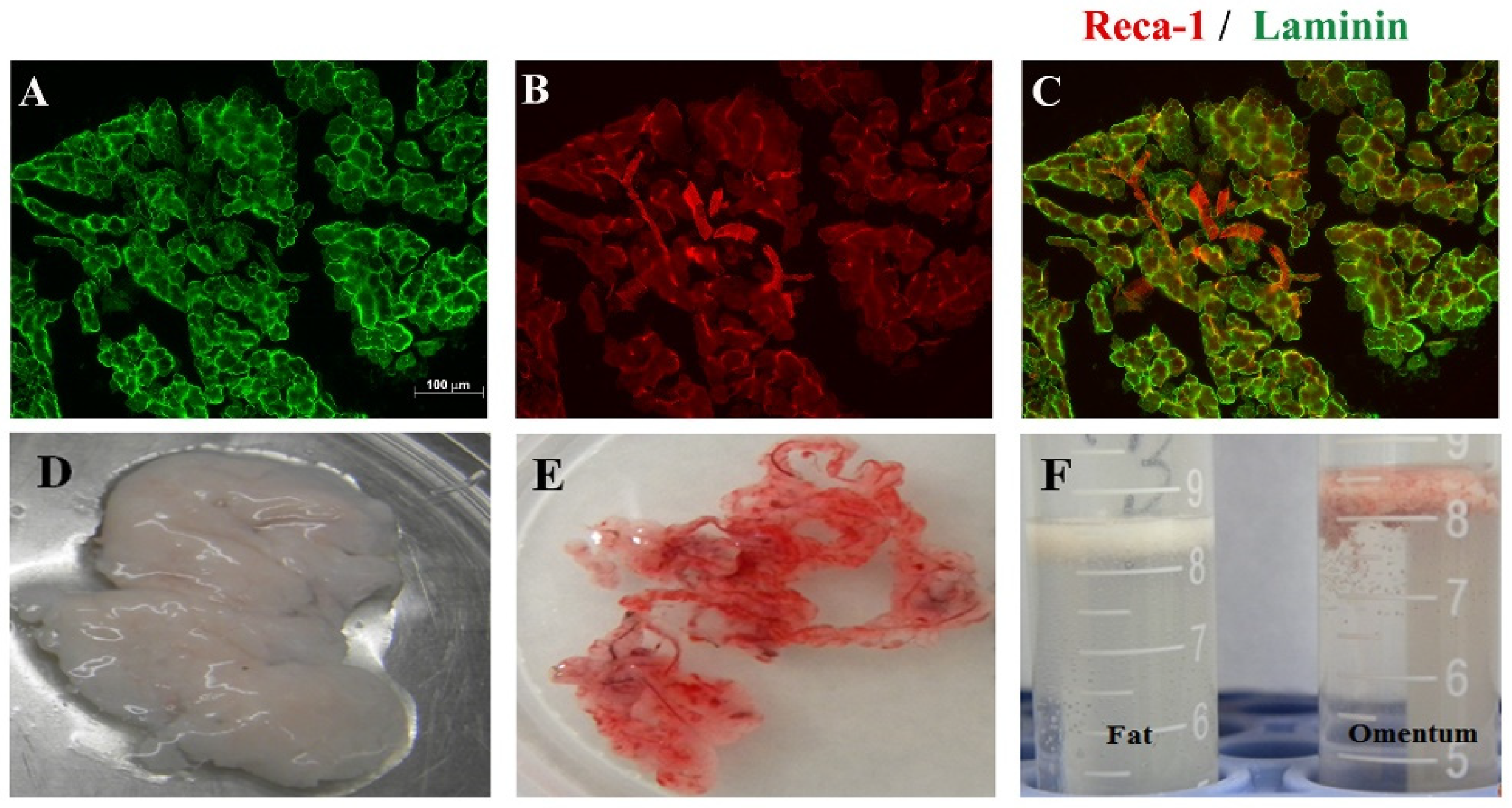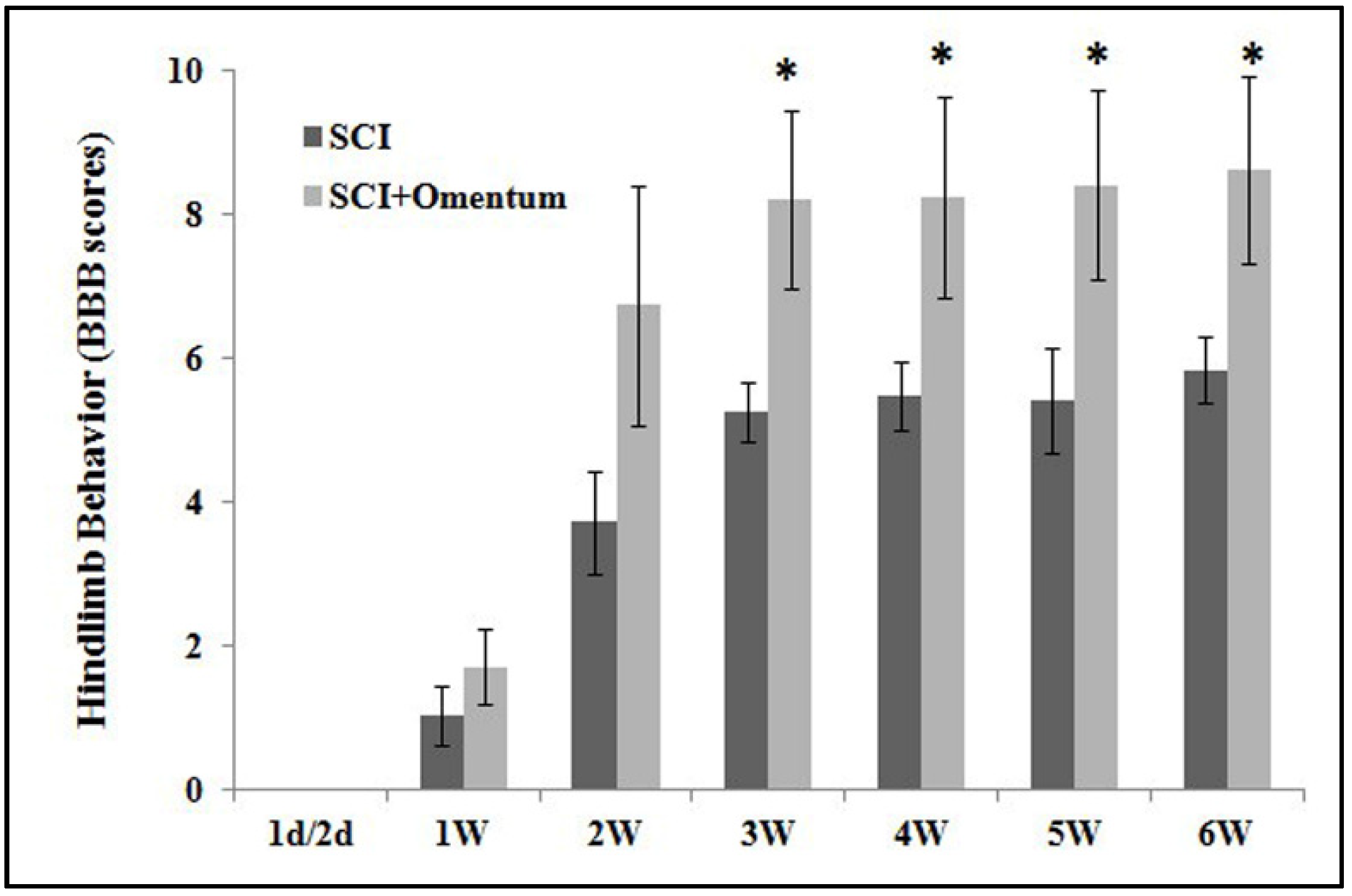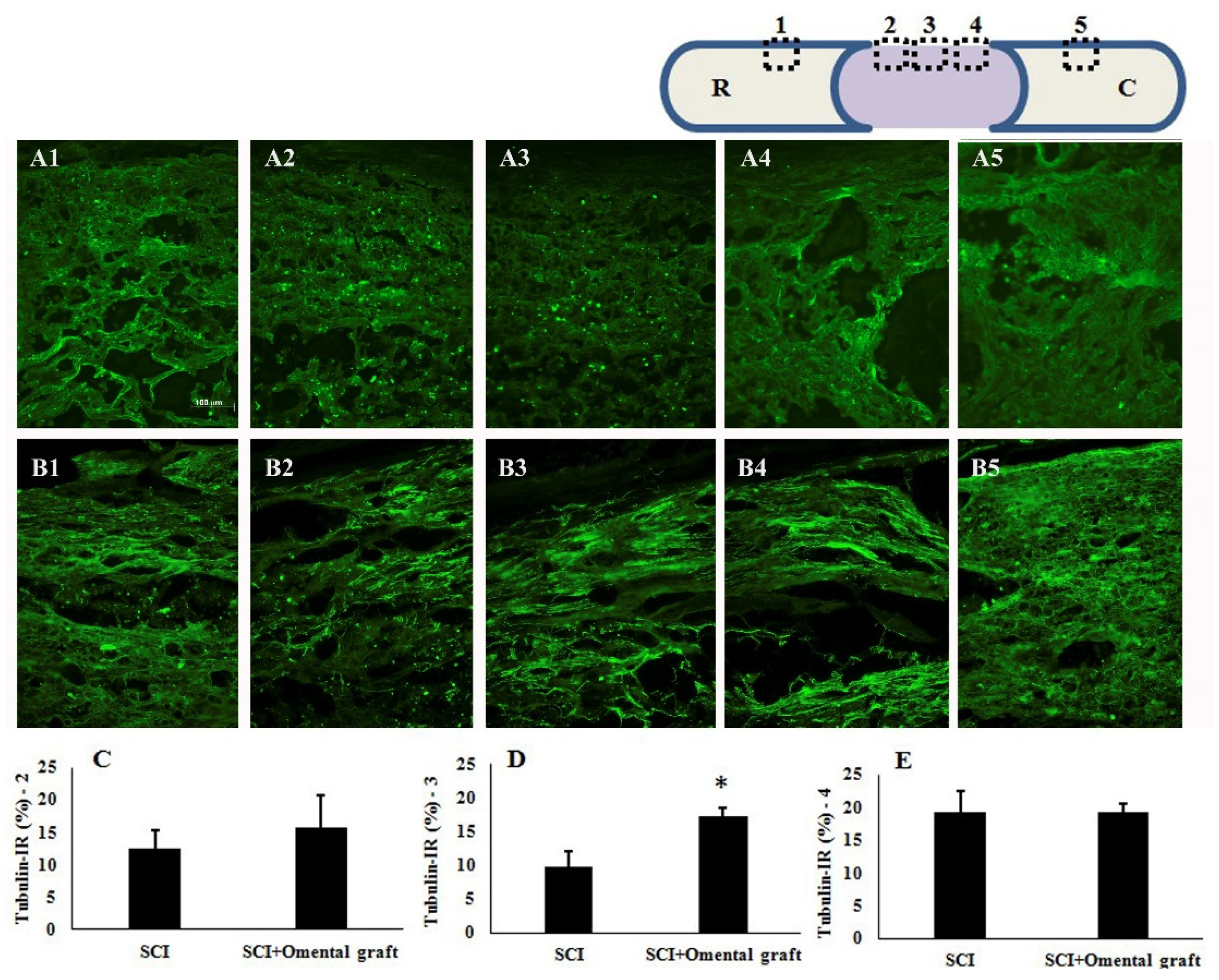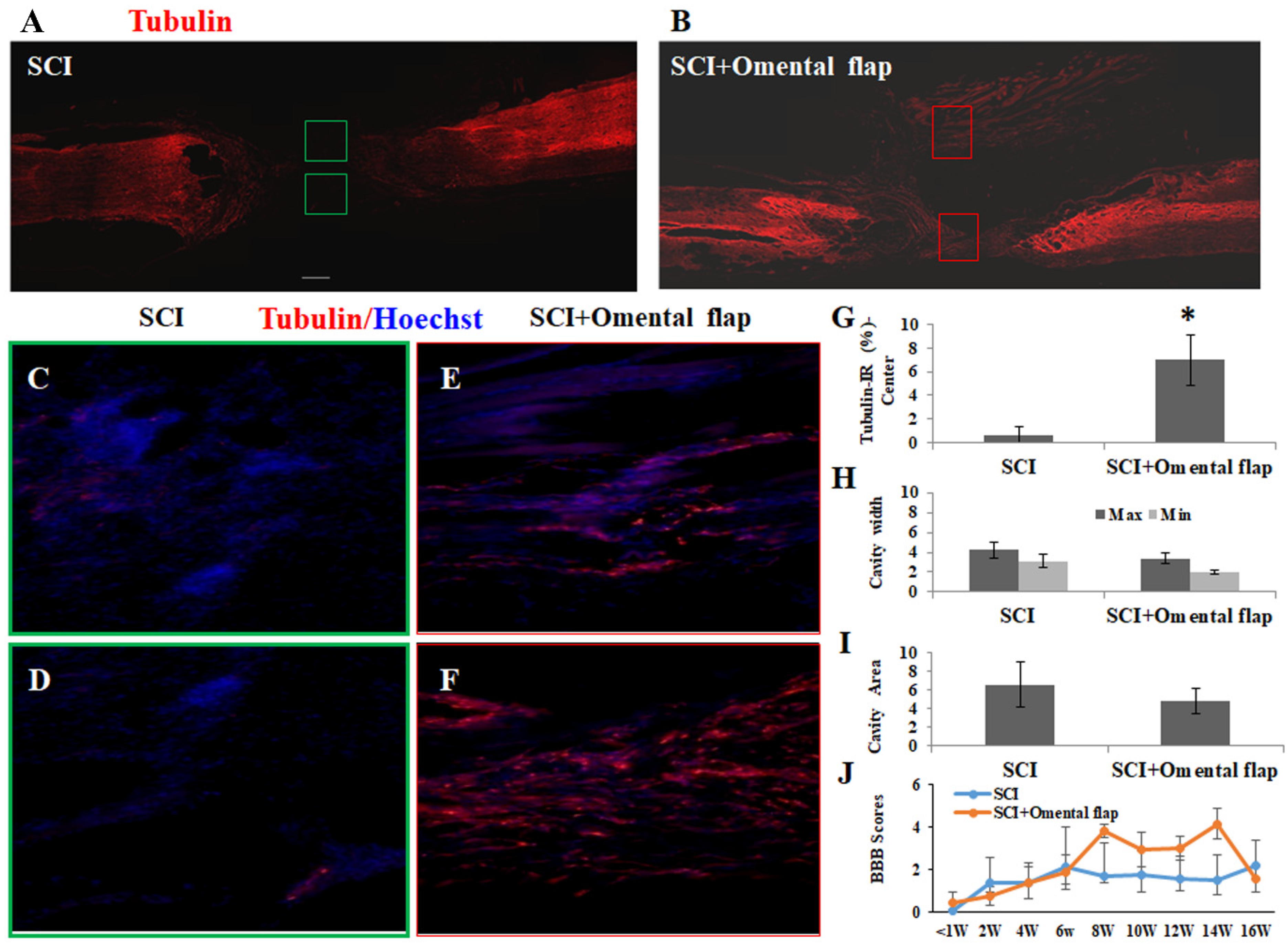The Application of an Omentum Graft or Flap in Spinal Cord Injury
Abstract
:1. Introduction
2. Results
2.1. Identification of Rat Omentum
2.2. Beneficial Effect of the Omentum Graft in Contusive SCI Rats
2.3. Vascularity of the Omental Flap and Application in Transected SCI Rats
3. Discussion
4. Materials and Methods
4.1. Reagents and Antibodies
4.2. Omentum Graft or Flap
4.3. Spinal Cord Injury and Treatment
4.4. Behavioral Examination
4.5. Immunohistochemistry Analysis
4.6. Statistical Analysis
Author Contributions
Funding
Institutional Review Board Statement
Informed Consent Statement
Data Availability Statement
Acknowledgments
Conflicts of Interest
References
- Schwab, M.E.; Bartholdi, D. Degeneration and regeneration of axons in the lesioned spinal cord. Physiol. Rev. 1996, 76, 319–370. [Google Scholar] [CrossRef]
- Thuret, S.; Moon, L.D.; Gage, F.H. Therapeutic interventions after spinal cord injury. Nat. Rev. Neurosci. 2006, 7, 628–643. [Google Scholar] [CrossRef] [PubMed]
- Yip, P.K.; Malaspina, A. Spinal cord trauma and the molecular point of no return. Mol. Neurodegener. 2012, 7, 6. [Google Scholar] [CrossRef] [PubMed] [Green Version]
- Sinescu, C.; Popa, F.; Grigorean, V.T.; Onose, G.; Sandu, A.M.; Popescu, M.; Burnei, G.; Strambu, V.; Popa, C. Molecular basis of vascular events following spinal cord injury. J. Med. Life 2010, 3, 254–261. [Google Scholar] [PubMed]
- Goel, A. Stem cell therapy in spinal cord injury: Hollow promise or promising science? J. Craniovertebr. Junction Spine 2016, 7, 121–126. [Google Scholar] [CrossRef]
- Cheng, H.; Cao, Y.; Olson, L. Spinal cord repair in adult paraplegic rats: Partial restoration of hind limb function. Science 1996, 273, 510–513. [Google Scholar] [CrossRef]
- Tsai, M.C.; Shen, L.F.; Kuo, H.S.; Cheng, H.; Chak, K.F. Involvement of acidic fibroblast growth factor in spinal cord injury repair processes revealed by a proteomics approach. Mol. Cell Proteom. 2008, 7, 1668–1687. [Google Scholar] [CrossRef] [Green Version]
- Wu, J.C.; Huang, W.C.; Tsai, Y.A.; Chen, Y.C.; Cheng, H. Nerve repair using acidic fibroblast growth factor in human cervical spinal cord injury: A preliminary Phase I clinical study. J. Neurosurg. Spine 2008, 8, 208–214. [Google Scholar] [CrossRef]
- Huang, W.C.; Kuo, H.S.; Tsai, M.J.; Ma, H.; Chiu, C.W.; Huang, M.C.; Yang, L.H.; Chang, P.T.; Lin, Y.L.; Kuo, W.C.; et al. Adeno-associated virus-mediated human acidic fibroblast growth factor expression promotes functional recovery of spinal cord-contused rats. J. Gene. Med. 2011, 13, 283–289. [Google Scholar] [CrossRef]
- Wu, J.C.; Huang, W.C.; Chen, Y.C.; Tu, T.H.; Tsai, Y.A.; Huang, S.F.; Huang, H.C.; Cheng, H. Acidic fibroblast growth factor for repair of human spinal cord injury: A clinical trial. J. Neurosurg. Spine 2011, 15, 216–227. [Google Scholar] [CrossRef]
- Ko, C.C.; Tu, T.H.; Wu, J.C.; Huang, W.C.; Tsai, Y.A.; Huang, S.F.; Huang, H.C.; Cheng, H. Functional improvement in chronic human spinal cord injury: Four years after acidic fibroblast growth factor. Sci. Rep. 2018, 8, 12691. [Google Scholar] [CrossRef] [Green Version]
- Ko, C.C.; Tu, T.H.; Wu, J.C.; Huang, W.C.; Cheng, H. Acidic Fibroblast Growth Factor in Spinal Cord Injury. Neurospine 2019, 16, 728–738. [Google Scholar] [CrossRef]
- Tu, T.H.; Liou, D.Y.; Lin, D.Y.; Yang, H.C.; Chen, C.J.; Huang, M.C.; Huang, W.C.; Tsai, M.J.; Cheng, H. Characterizing the Neuroprotective Effects of S/B Remedy (Scutellaria baicalensis Georgi and Bupleurum scorzonerifolfium Willd) in Spinal Cord Injury. Molecules 2019, 24, 1885. [Google Scholar] [CrossRef] [Green Version]
- Goldsmith, H.S. Treatment of acute spinal cord injury by omental transposition: A new approach. J. Am. Coll. Surg. 2009, 208, 289–292. [Google Scholar] [CrossRef] [PubMed]
- Rafael, H. Omental transplantation for cervical degenerative disease. J. Neurosurg. Spine 2010, 13, 139–140. [Google Scholar] [CrossRef] [PubMed]
- Duffill, J.; Buckley, J.; Lang, D.; Neil-Dwyer, G.; McGinn, F.; Wade, D. Prospective study of omental transposition in patients with chronic spinal injury. J. Neurol. Neurosurg. Psychiatry 2001, 71, 73–80. [Google Scholar] [CrossRef] [Green Version]
- Clifton, G.L.; Donovan, W.H.; Dimitrijevic, M.M.; Allen, S.J.; Ku, A.; Potts, J.R., 3rd; Moody, F.G.; Boake, C.; Sherwood, A.M.; Edwards, J.V. Omental transposition in chronic spinal cord injury. Spinal Cord 1996, 34, 193–203. [Google Scholar] [CrossRef] [Green Version]
- Goldsmith, H.S. Omental transposition in chronic spinal cord injury. Spinal Cord 1997, 35, 189–190. [Google Scholar] [CrossRef] [PubMed] [Green Version]
- Timpl, R.; Rohde, H.; Robey, P.G.; Rennard, S.I.; Foidart, J.M.; Martin, G.R. Laminin—A glycoprotein from basement membranes. J. Biol. Chem. 1979, 254, 9933–9937. [Google Scholar] [CrossRef]
- Nieuwenhuis, B.; Haenzi, B.; Andrews, M.R.; Verhaagen, J.; Fawcett, J.W. Integrins promote axonal regeneration after injury of the nervous system. Biol. Rev. 2018, 93, 1339–1362. [Google Scholar] [CrossRef] [PubMed]
- Ackermann, P.C.; De Wet, P.D.; Loots, G.P. Microcirculation of the rat omentum studied by means of corrosion casts. Acta. Anat. 1991, 140, 146–149. [Google Scholar] [CrossRef] [PubMed]
- Liebermann-Meffert, D. The greater omentum. Anatomy, embryology, and surgical applications. Surg. Clin. North. Am. 2000, 80, 275–293. [Google Scholar] [CrossRef]
- Collins, D.; Hogan, A.M.; O’Shea, D.; Winter, D.C. The omentum: Anatomical, metabolic, and surgical aspects. J. Gastrointest. Surg. 2009, 13, 1138–1146. [Google Scholar] [CrossRef]
- Goldsmith, H.S.; Steward, E.; Duckett, S. Early application of pedicled omentum to the acutely traumatised spinal cord. Paraplegia 1985, 23, 100–112. [Google Scholar] [CrossRef] [PubMed] [Green Version]
- Chooramani, G.S.; Singh, G.K.; Srivastava, R.N.; Jaiswal, P.K.; Srivastava, C. Chooramani technique: A novel method of omental transposition in traumatic spinal cord injury. Asian J. Neurosurg. 2013, 8, 179–182. [Google Scholar] [CrossRef] [PubMed] [Green Version]
- Goldsmith, H.S.; de la Torre, J.C. Axonal regeneration after spinal cord transection and reconstruction. Brain Res. 1992, 589, 217–224. [Google Scholar] [CrossRef]
- Goldsmith, H.S. Brain and spinal cord revascularization by omental transposition. Neurol. Res. 1994, 16, 159–162. [Google Scholar] [CrossRef]
- Goldsmith, H.S.; De los Santos, R.; Beattie, E.J., Jr. Relief of chronic lymphedema by omental transposition. Ann. Surg. 1967, 166, 573–585. [Google Scholar] [CrossRef]
- Goldsmith, H.S.; Steward, E. Vascularization of brain and spinal cord by intact omentum. Appl. Neurophysiol. 1984, 47, 57–61. [Google Scholar] [CrossRef]
- Goldsmith, H.S.; McIntosh, T.; Vezina, R.M.; Colton, T. Vasoactive neurochemicals identified in omentum: A preliminary report. Br. J. Neurosurg. 1987, 1, 359–364. [Google Scholar] [CrossRef] [PubMed]
- Dujovny, M.; Ding, Y.H.; Ding, Y.; Agner, C.; Perez-Arjona, E. Current concepts on the expression of neurotrophins in the greater omentum. Neurol. Res. 2004, 26, 226–229. [Google Scholar] [CrossRef] [PubMed]
- Tsai, M.J.; Liao, J.F.; Lin, D.Y.; Huang, M.C.; Liou, D.Y.; Yang, H.C.; Lee, H.J.; Chen, Y.T.; Chi, C.W.; Huang, W.C.; et al. Silymarin protects spinal cord and cortical cells against oxidative stress and lipopolysaccharide stimulation. Neurochem. Int. 2010, 57, 867–875. [Google Scholar] [CrossRef]
- Tsai, M.J.; Liou, D.Y.; Lin, Y.R.; Weng, C.F.; Huang, M.C.; Huang, W.C.; Tseng, F.W.; Cheng, H. Attenuating Spinal Cord Injury by Conditioned Medium from Bone Marrow Mesenchymal Stem Cells. J. Clin. Med. 2018, 8, 23. [Google Scholar] [CrossRef] [PubMed] [Green Version]
- Basso, D.M.; Beattie, M.S.; Bresnahan, J.C. A sensitive and reliable locomotor rating scale for open field testing in rats. J. Neurotrauma 1995, 12, 1–21. [Google Scholar] [CrossRef] [PubMed]
- Tsai, C.Y.; Delgado, A.D.; Weinrauch, W.J.; Manente, N.; Levy, I.; Escalon, M.X.; Bryce, T.N.; Spungen, A.M. Exoskeletal-Assisted Walking during Acute Inpatient Rehabilitation Leads to Motor and Functional Improvement in Persons with Spinal Cord Injury: A Pilot Study. Arch. Phys. Med. Rehabil. 2019, 101, 607–612. [Google Scholar] [CrossRef]






Publisher’s Note: MDPI stays neutral with regard to jurisdictional claims in published maps and institutional affiliations. |
© 2021 by the authors. Licensee MDPI, Basel, Switzerland. This article is an open access article distributed under the terms and conditions of the Creative Commons Attribution (CC BY) license (https://creativecommons.org/licenses/by/4.0/).
Share and Cite
Fay, L.-Y.; Lin, Y.-R.; Liou, D.-Y.; Chiu, C.-W.; Yeh, M.-Y.; Huang, W.-C.; Wu, J.-C.; Tsai, M.-J.; Cheng, H. The Application of an Omentum Graft or Flap in Spinal Cord Injury. Int. J. Mol. Sci. 2021, 22, 7930. https://doi.org/10.3390/ijms22157930
Fay L-Y, Lin Y-R, Liou D-Y, Chiu C-W, Yeh M-Y, Huang W-C, Wu J-C, Tsai M-J, Cheng H. The Application of an Omentum Graft or Flap in Spinal Cord Injury. International Journal of Molecular Sciences. 2021; 22(15):7930. https://doi.org/10.3390/ijms22157930
Chicago/Turabian StyleFay, Li-Yu, Yan-Ru Lin, Dann-Ying Liou, Chuan-Wen Chiu, Mei-Yin Yeh, Wen-Cheng Huang, Jau-Ching Wu, May-Jywan Tsai, and Henrich Cheng. 2021. "The Application of an Omentum Graft or Flap in Spinal Cord Injury" International Journal of Molecular Sciences 22, no. 15: 7930. https://doi.org/10.3390/ijms22157930





